MgMT20144 Essay: Globalisation and Contemporary Companies
VerifiedAdded on 2022/11/09
|10
|2704
|342
Essay
AI Summary
This essay provides a comprehensive overview of globalisation and its multifaceted impact on contemporary businesses. It begins by defining globalisation and highlighting its role in facilitating international trade and economic integration. The essay then delves into the advantages of globalisation, such as the free flow of goods and services, access to a global talent pool, and increased communication, while also acknowledging the disadvantages, including income inequality, environmental damage, and economic vulnerabilities. The discussion further explores contextual factors like knowledge management, e-commerce, and innovation, analyzing how companies can navigate the challenges and leverage opportunities presented by globalisation. The essay emphasizes the importance of adapting to global market dynamics and implementing effective strategies for sustainable growth, drawing on real-world examples and research to support its arguments. The conclusion summarizes the key findings, emphasizing the significance of knowledge management and strategic adaptation in the context of a globalized business environment.
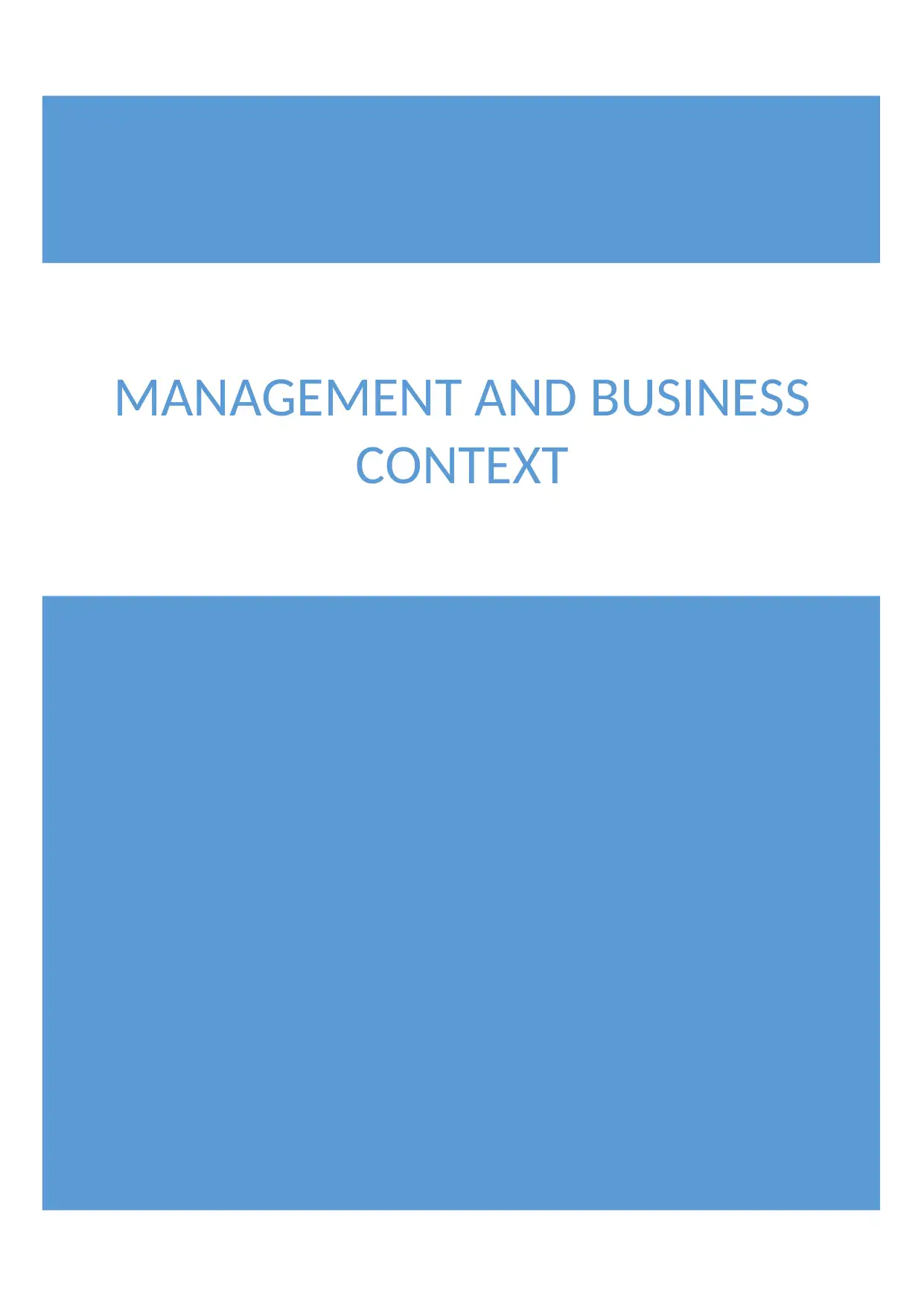
MANAGEMENT AND BUSINESS
CONTEXT
CONTEXT
Paraphrase This Document
Need a fresh take? Get an instant paraphrase of this document with our AI Paraphraser

Contents
Introduction...........................................................................................................................................2
Globalisation and its disadvantages and advantages..............................................................................2
Conclusion.............................................................................................................................................7
References.............................................................................................................................................8
Introduction...........................................................................................................................................2
Globalisation and its disadvantages and advantages..............................................................................2
Conclusion.............................................................................................................................................7
References.............................................................................................................................................8
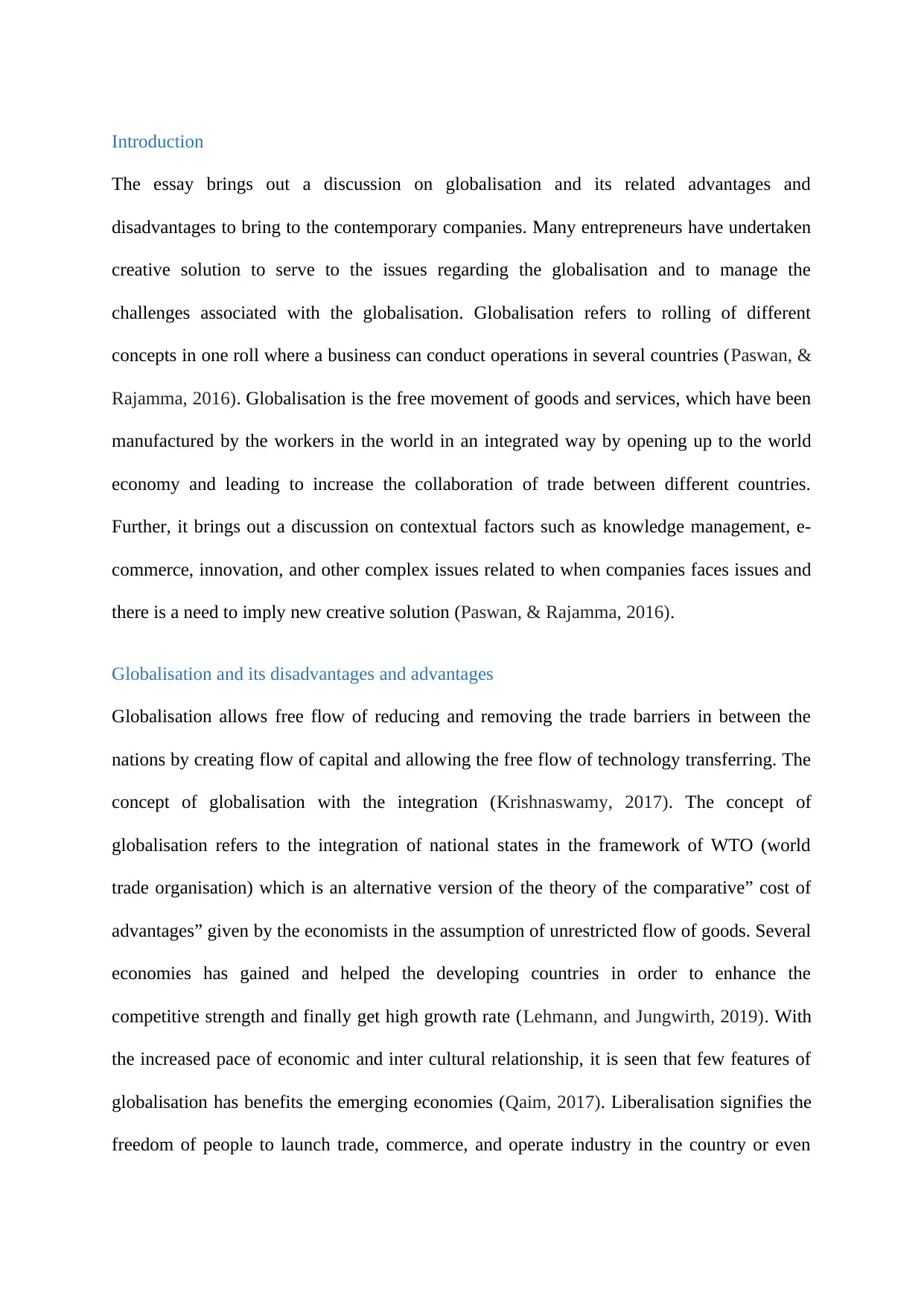
Introduction
The essay brings out a discussion on globalisation and its related advantages and
disadvantages to bring to the contemporary companies. Many entrepreneurs have undertaken
creative solution to serve to the issues regarding the globalisation and to manage the
challenges associated with the globalisation. Globalisation refers to rolling of different
concepts in one roll where a business can conduct operations in several countries (Paswan, &
Rajamma, 2016). Globalisation is the free movement of goods and services, which have been
manufactured by the workers in the world in an integrated way by opening up to the world
economy and leading to increase the collaboration of trade between different countries.
Further, it brings out a discussion on contextual factors such as knowledge management, e-
commerce, innovation, and other complex issues related to when companies faces issues and
there is a need to imply new creative solution (Paswan, & Rajamma, 2016).
Globalisation and its disadvantages and advantages
Globalisation allows free flow of reducing and removing the trade barriers in between the
nations by creating flow of capital and allowing the free flow of technology transferring. The
concept of globalisation with the integration (Krishnaswamy, 2017). The concept of
globalisation refers to the integration of national states in the framework of WTO (world
trade organisation) which is an alternative version of the theory of the comparative” cost of
advantages” given by the economists in the assumption of unrestricted flow of goods. Several
economies has gained and helped the developing countries in order to enhance the
competitive strength and finally get high growth rate (Lehmann, and Jungwirth, 2019). With
the increased pace of economic and inter cultural relationship, it is seen that few features of
globalisation has benefits the emerging economies (Qaim, 2017). Liberalisation signifies the
freedom of people to launch trade, commerce, and operate industry in the country or even
The essay brings out a discussion on globalisation and its related advantages and
disadvantages to bring to the contemporary companies. Many entrepreneurs have undertaken
creative solution to serve to the issues regarding the globalisation and to manage the
challenges associated with the globalisation. Globalisation refers to rolling of different
concepts in one roll where a business can conduct operations in several countries (Paswan, &
Rajamma, 2016). Globalisation is the free movement of goods and services, which have been
manufactured by the workers in the world in an integrated way by opening up to the world
economy and leading to increase the collaboration of trade between different countries.
Further, it brings out a discussion on contextual factors such as knowledge management, e-
commerce, innovation, and other complex issues related to when companies faces issues and
there is a need to imply new creative solution (Paswan, & Rajamma, 2016).
Globalisation and its disadvantages and advantages
Globalisation allows free flow of reducing and removing the trade barriers in between the
nations by creating flow of capital and allowing the free flow of technology transferring. The
concept of globalisation with the integration (Krishnaswamy, 2017). The concept of
globalisation refers to the integration of national states in the framework of WTO (world
trade organisation) which is an alternative version of the theory of the comparative” cost of
advantages” given by the economists in the assumption of unrestricted flow of goods. Several
economies has gained and helped the developing countries in order to enhance the
competitive strength and finally get high growth rate (Lehmann, and Jungwirth, 2019). With
the increased pace of economic and inter cultural relationship, it is seen that few features of
globalisation has benefits the emerging economies (Qaim, 2017). Liberalisation signifies the
freedom of people to launch trade, commerce, and operate industry in the country or even
⊘ This is a preview!⊘
Do you want full access?
Subscribe today to unlock all pages.

Trusted by 1+ million students worldwide
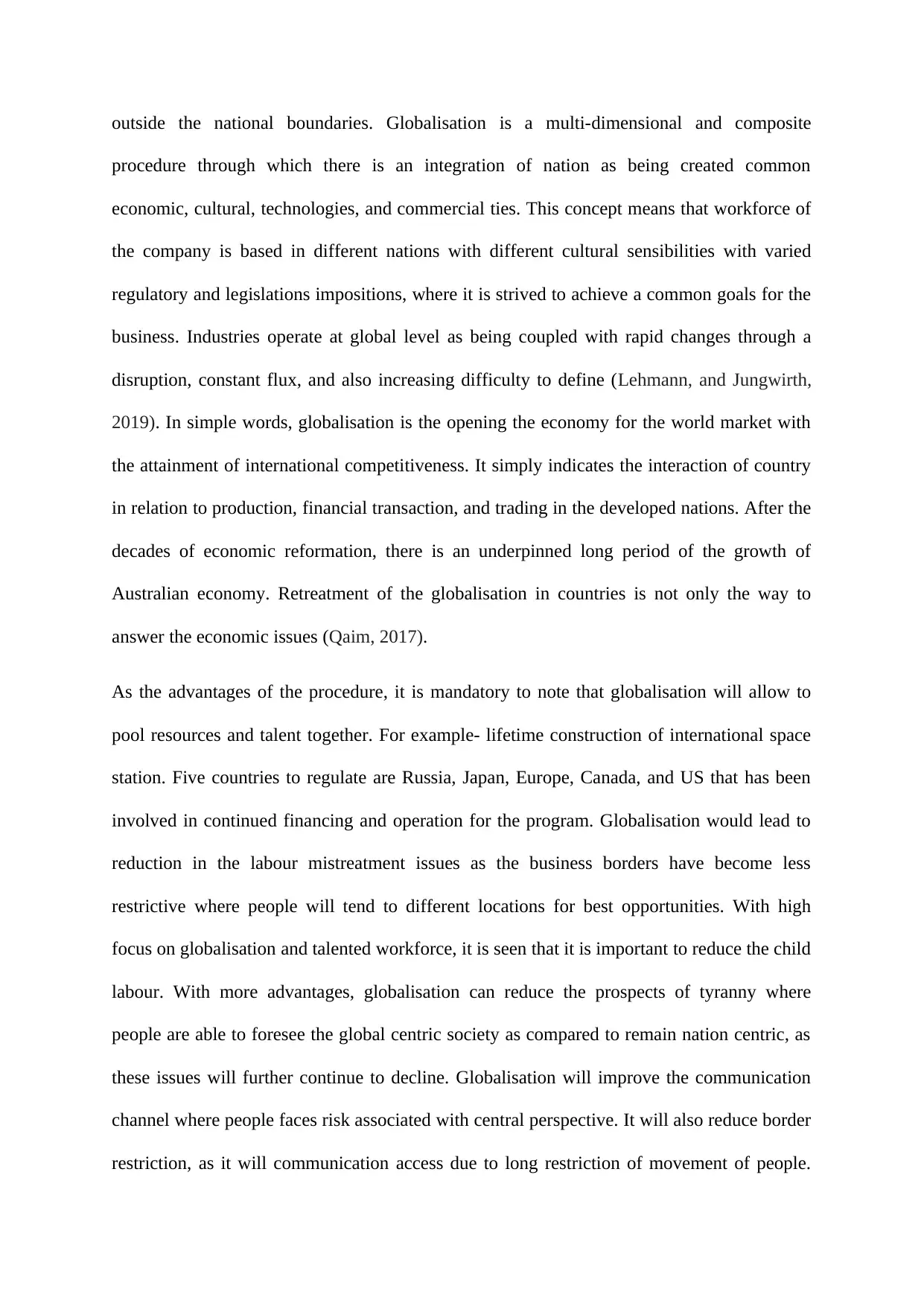
outside the national boundaries. Globalisation is a multi-dimensional and composite
procedure through which there is an integration of nation as being created common
economic, cultural, technologies, and commercial ties. This concept means that workforce of
the company is based in different nations with different cultural sensibilities with varied
regulatory and legislations impositions, where it is strived to achieve a common goals for the
business. Industries operate at global level as being coupled with rapid changes through a
disruption, constant flux, and also increasing difficulty to define (Lehmann, and Jungwirth,
2019). In simple words, globalisation is the opening the economy for the world market with
the attainment of international competitiveness. It simply indicates the interaction of country
in relation to production, financial transaction, and trading in the developed nations. After the
decades of economic reformation, there is an underpinned long period of the growth of
Australian economy. Retreatment of the globalisation in countries is not only the way to
answer the economic issues (Qaim, 2017).
As the advantages of the procedure, it is mandatory to note that globalisation will allow to
pool resources and talent together. For example- lifetime construction of international space
station. Five countries to regulate are Russia, Japan, Europe, Canada, and US that has been
involved in continued financing and operation for the program. Globalisation would lead to
reduction in the labour mistreatment issues as the business borders have become less
restrictive where people will tend to different locations for best opportunities. With high
focus on globalisation and talented workforce, it is seen that it is important to reduce the child
labour. With more advantages, globalisation can reduce the prospects of tyranny where
people are able to foresee the global centric society as compared to remain nation centric, as
these issues will further continue to decline. Globalisation will improve the communication
channel where people faces risk associated with central perspective. It will also reduce border
restriction, as it will communication access due to long restriction of movement of people.
procedure through which there is an integration of nation as being created common
economic, cultural, technologies, and commercial ties. This concept means that workforce of
the company is based in different nations with different cultural sensibilities with varied
regulatory and legislations impositions, where it is strived to achieve a common goals for the
business. Industries operate at global level as being coupled with rapid changes through a
disruption, constant flux, and also increasing difficulty to define (Lehmann, and Jungwirth,
2019). In simple words, globalisation is the opening the economy for the world market with
the attainment of international competitiveness. It simply indicates the interaction of country
in relation to production, financial transaction, and trading in the developed nations. After the
decades of economic reformation, there is an underpinned long period of the growth of
Australian economy. Retreatment of the globalisation in countries is not only the way to
answer the economic issues (Qaim, 2017).
As the advantages of the procedure, it is mandatory to note that globalisation will allow to
pool resources and talent together. For example- lifetime construction of international space
station. Five countries to regulate are Russia, Japan, Europe, Canada, and US that has been
involved in continued financing and operation for the program. Globalisation would lead to
reduction in the labour mistreatment issues as the business borders have become less
restrictive where people will tend to different locations for best opportunities. With high
focus on globalisation and talented workforce, it is seen that it is important to reduce the child
labour. With more advantages, globalisation can reduce the prospects of tyranny where
people are able to foresee the global centric society as compared to remain nation centric, as
these issues will further continue to decline. Globalisation will improve the communication
channel where people faces risk associated with central perspective. It will also reduce border
restriction, as it will communication access due to long restriction of movement of people.
Paraphrase This Document
Need a fresh take? Get an instant paraphrase of this document with our AI Paraphraser
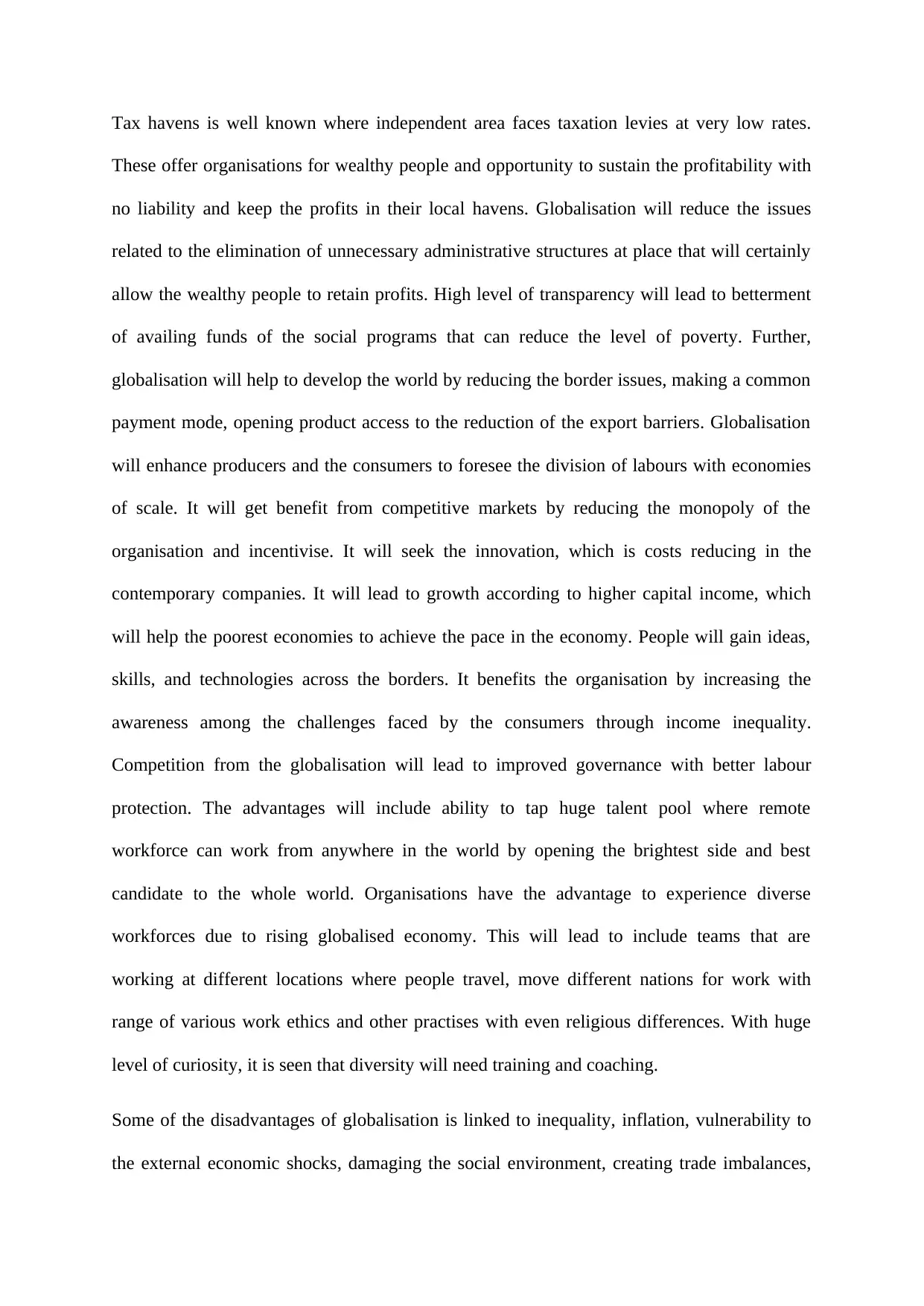
Tax havens is well known where independent area faces taxation levies at very low rates.
These offer organisations for wealthy people and opportunity to sustain the profitability with
no liability and keep the profits in their local havens. Globalisation will reduce the issues
related to the elimination of unnecessary administrative structures at place that will certainly
allow the wealthy people to retain profits. High level of transparency will lead to betterment
of availing funds of the social programs that can reduce the level of poverty. Further,
globalisation will help to develop the world by reducing the border issues, making a common
payment mode, opening product access to the reduction of the export barriers. Globalisation
will enhance producers and the consumers to foresee the division of labours with economies
of scale. It will get benefit from competitive markets by reducing the monopoly of the
organisation and incentivise. It will seek the innovation, which is costs reducing in the
contemporary companies. It will lead to growth according to higher capital income, which
will help the poorest economies to achieve the pace in the economy. People will gain ideas,
skills, and technologies across the borders. It benefits the organisation by increasing the
awareness among the challenges faced by the consumers through income inequality.
Competition from the globalisation will lead to improved governance with better labour
protection. The advantages will include ability to tap huge talent pool where remote
workforce can work from anywhere in the world by opening the brightest side and best
candidate to the whole world. Organisations have the advantage to experience diverse
workforces due to rising globalised economy. This will lead to include teams that are
working at different locations where people travel, move different nations for work with
range of various work ethics and other practises with even religious differences. With huge
level of curiosity, it is seen that diversity will need training and coaching.
Some of the disadvantages of globalisation is linked to inequality, inflation, vulnerability to
the external economic shocks, damaging the social environment, creating trade imbalances,
These offer organisations for wealthy people and opportunity to sustain the profitability with
no liability and keep the profits in their local havens. Globalisation will reduce the issues
related to the elimination of unnecessary administrative structures at place that will certainly
allow the wealthy people to retain profits. High level of transparency will lead to betterment
of availing funds of the social programs that can reduce the level of poverty. Further,
globalisation will help to develop the world by reducing the border issues, making a common
payment mode, opening product access to the reduction of the export barriers. Globalisation
will enhance producers and the consumers to foresee the division of labours with economies
of scale. It will get benefit from competitive markets by reducing the monopoly of the
organisation and incentivise. It will seek the innovation, which is costs reducing in the
contemporary companies. It will lead to growth according to higher capital income, which
will help the poorest economies to achieve the pace in the economy. People will gain ideas,
skills, and technologies across the borders. It benefits the organisation by increasing the
awareness among the challenges faced by the consumers through income inequality.
Competition from the globalisation will lead to improved governance with better labour
protection. The advantages will include ability to tap huge talent pool where remote
workforce can work from anywhere in the world by opening the brightest side and best
candidate to the whole world. Organisations have the advantage to experience diverse
workforces due to rising globalised economy. This will lead to include teams that are
working at different locations where people travel, move different nations for work with
range of various work ethics and other practises with even religious differences. With huge
level of curiosity, it is seen that diversity will need training and coaching.
Some of the disadvantages of globalisation is linked to inequality, inflation, vulnerability to
the external economic shocks, damaging the social environment, creating trade imbalances,
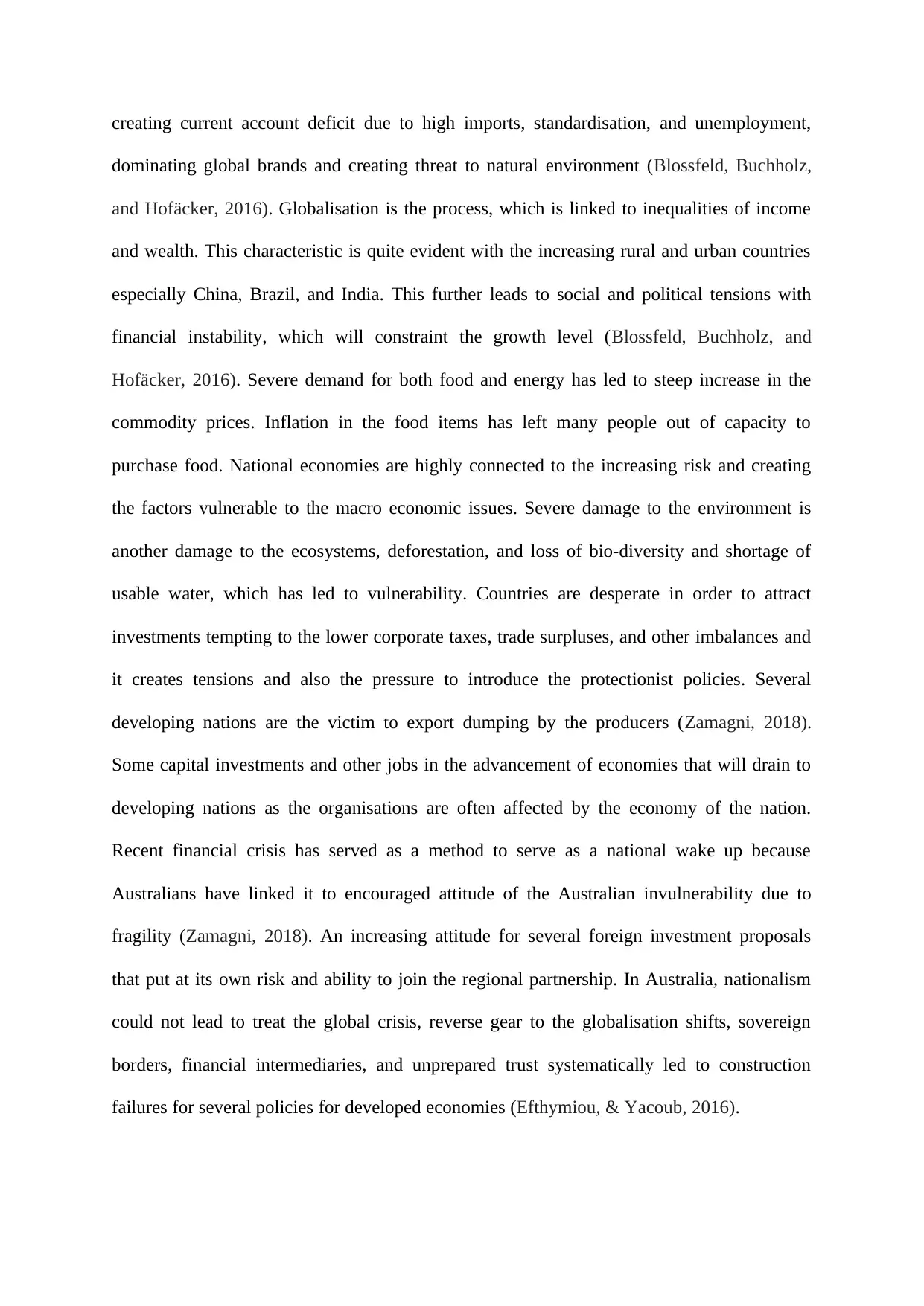
creating current account deficit due to high imports, standardisation, and unemployment,
dominating global brands and creating threat to natural environment (Blossfeld, Buchholz,
and Hofäcker, 2016). Globalisation is the process, which is linked to inequalities of income
and wealth. This characteristic is quite evident with the increasing rural and urban countries
especially China, Brazil, and India. This further leads to social and political tensions with
financial instability, which will constraint the growth level (Blossfeld, Buchholz, and
Hofäcker, 2016). Severe demand for both food and energy has led to steep increase in the
commodity prices. Inflation in the food items has left many people out of capacity to
purchase food. National economies are highly connected to the increasing risk and creating
the factors vulnerable to the macro economic issues. Severe damage to the environment is
another damage to the ecosystems, deforestation, and loss of bio-diversity and shortage of
usable water, which has led to vulnerability. Countries are desperate in order to attract
investments tempting to the lower corporate taxes, trade surpluses, and other imbalances and
it creates tensions and also the pressure to introduce the protectionist policies. Several
developing nations are the victim to export dumping by the producers (Zamagni, 2018).
Some capital investments and other jobs in the advancement of economies that will drain to
developing nations as the organisations are often affected by the economy of the nation.
Recent financial crisis has served as a method to serve as a national wake up because
Australians have linked it to encouraged attitude of the Australian invulnerability due to
fragility (Zamagni, 2018). An increasing attitude for several foreign investment proposals
that put at its own risk and ability to join the regional partnership. In Australia, nationalism
could not lead to treat the global crisis, reverse gear to the globalisation shifts, sovereign
borders, financial intermediaries, and unprepared trust systematically led to construction
failures for several policies for developed economies (Efthymiou, & Yacoub, 2016).
dominating global brands and creating threat to natural environment (Blossfeld, Buchholz,
and Hofäcker, 2016). Globalisation is the process, which is linked to inequalities of income
and wealth. This characteristic is quite evident with the increasing rural and urban countries
especially China, Brazil, and India. This further leads to social and political tensions with
financial instability, which will constraint the growth level (Blossfeld, Buchholz, and
Hofäcker, 2016). Severe demand for both food and energy has led to steep increase in the
commodity prices. Inflation in the food items has left many people out of capacity to
purchase food. National economies are highly connected to the increasing risk and creating
the factors vulnerable to the macro economic issues. Severe damage to the environment is
another damage to the ecosystems, deforestation, and loss of bio-diversity and shortage of
usable water, which has led to vulnerability. Countries are desperate in order to attract
investments tempting to the lower corporate taxes, trade surpluses, and other imbalances and
it creates tensions and also the pressure to introduce the protectionist policies. Several
developing nations are the victim to export dumping by the producers (Zamagni, 2018).
Some capital investments and other jobs in the advancement of economies that will drain to
developing nations as the organisations are often affected by the economy of the nation.
Recent financial crisis has served as a method to serve as a national wake up because
Australians have linked it to encouraged attitude of the Australian invulnerability due to
fragility (Zamagni, 2018). An increasing attitude for several foreign investment proposals
that put at its own risk and ability to join the regional partnership. In Australia, nationalism
could not lead to treat the global crisis, reverse gear to the globalisation shifts, sovereign
borders, financial intermediaries, and unprepared trust systematically led to construction
failures for several policies for developed economies (Efthymiou, & Yacoub, 2016).
⊘ This is a preview!⊘
Do you want full access?
Subscribe today to unlock all pages.

Trusted by 1+ million students worldwide
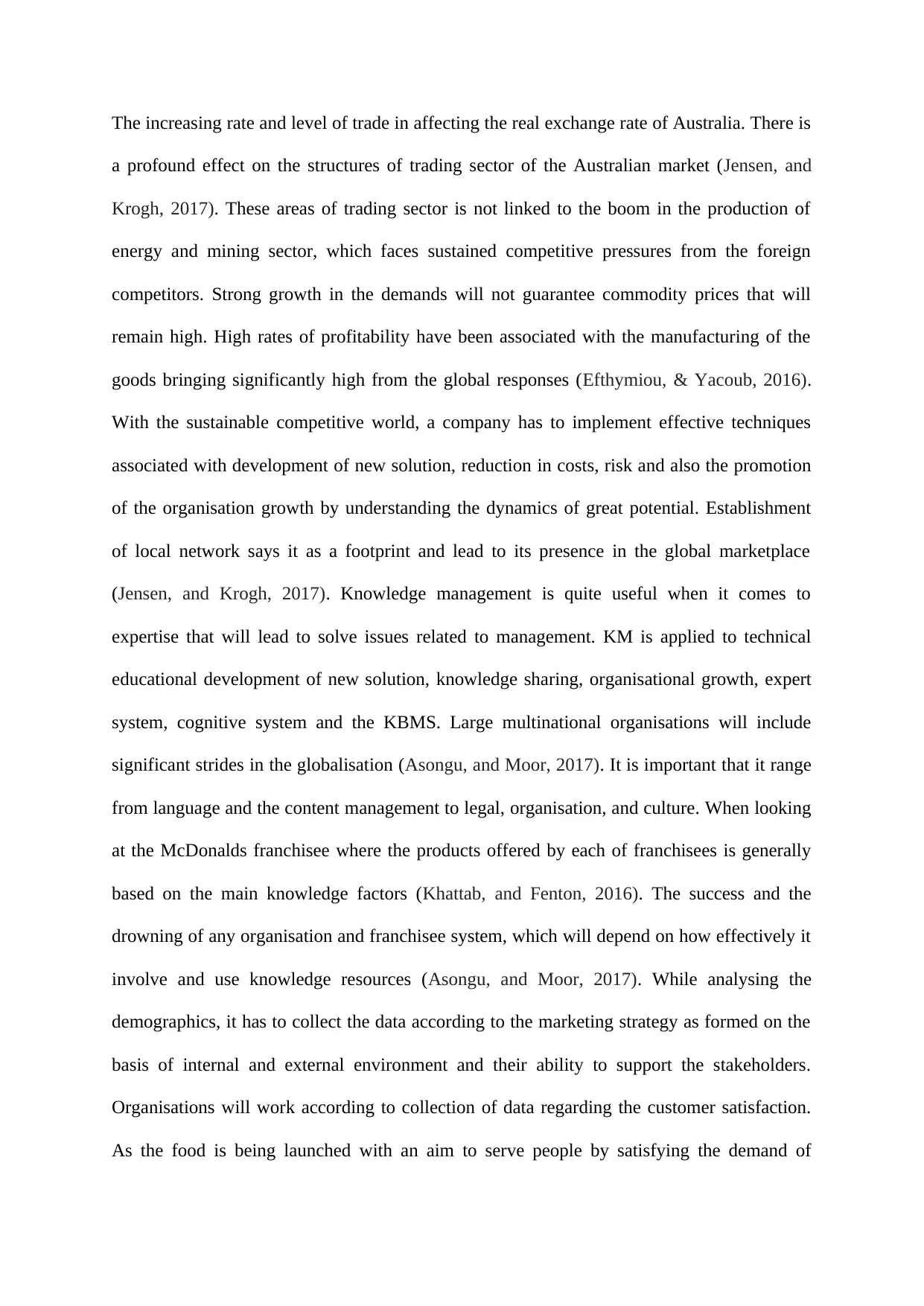
The increasing rate and level of trade in affecting the real exchange rate of Australia. There is
a profound effect on the structures of trading sector of the Australian market (Jensen, and
Krogh, 2017). These areas of trading sector is not linked to the boom in the production of
energy and mining sector, which faces sustained competitive pressures from the foreign
competitors. Strong growth in the demands will not guarantee commodity prices that will
remain high. High rates of profitability have been associated with the manufacturing of the
goods bringing significantly high from the global responses (Efthymiou, & Yacoub, 2016).
With the sustainable competitive world, a company has to implement effective techniques
associated with development of new solution, reduction in costs, risk and also the promotion
of the organisation growth by understanding the dynamics of great potential. Establishment
of local network says it as a footprint and lead to its presence in the global marketplace
(Jensen, and Krogh, 2017). Knowledge management is quite useful when it comes to
expertise that will lead to solve issues related to management. KM is applied to technical
educational development of new solution, knowledge sharing, organisational growth, expert
system, cognitive system and the KBMS. Large multinational organisations will include
significant strides in the globalisation (Asongu, and Moor, 2017). It is important that it range
from language and the content management to legal, organisation, and culture. When looking
at the McDonalds franchisee where the products offered by each of franchisees is generally
based on the main knowledge factors (Khattab, and Fenton, 2016). The success and the
drowning of any organisation and franchisee system, which will depend on how effectively it
involve and use knowledge resources (Asongu, and Moor, 2017). While analysing the
demographics, it has to collect the data according to the marketing strategy as formed on the
basis of internal and external environment and their ability to support the stakeholders.
Organisations will work according to collection of data regarding the customer satisfaction.
As the food is being launched with an aim to serve people by satisfying the demand of
a profound effect on the structures of trading sector of the Australian market (Jensen, and
Krogh, 2017). These areas of trading sector is not linked to the boom in the production of
energy and mining sector, which faces sustained competitive pressures from the foreign
competitors. Strong growth in the demands will not guarantee commodity prices that will
remain high. High rates of profitability have been associated with the manufacturing of the
goods bringing significantly high from the global responses (Efthymiou, & Yacoub, 2016).
With the sustainable competitive world, a company has to implement effective techniques
associated with development of new solution, reduction in costs, risk and also the promotion
of the organisation growth by understanding the dynamics of great potential. Establishment
of local network says it as a footprint and lead to its presence in the global marketplace
(Jensen, and Krogh, 2017). Knowledge management is quite useful when it comes to
expertise that will lead to solve issues related to management. KM is applied to technical
educational development of new solution, knowledge sharing, organisational growth, expert
system, cognitive system and the KBMS. Large multinational organisations will include
significant strides in the globalisation (Asongu, and Moor, 2017). It is important that it range
from language and the content management to legal, organisation, and culture. When looking
at the McDonalds franchisee where the products offered by each of franchisees is generally
based on the main knowledge factors (Khattab, and Fenton, 2016). The success and the
drowning of any organisation and franchisee system, which will depend on how effectively it
involve and use knowledge resources (Asongu, and Moor, 2017). While analysing the
demographics, it has to collect the data according to the marketing strategy as formed on the
basis of internal and external environment and their ability to support the stakeholders.
Organisations will work according to collection of data regarding the customer satisfaction.
As the food is being launched with an aim to serve people by satisfying the demand of
Paraphrase This Document
Need a fresh take? Get an instant paraphrase of this document with our AI Paraphraser
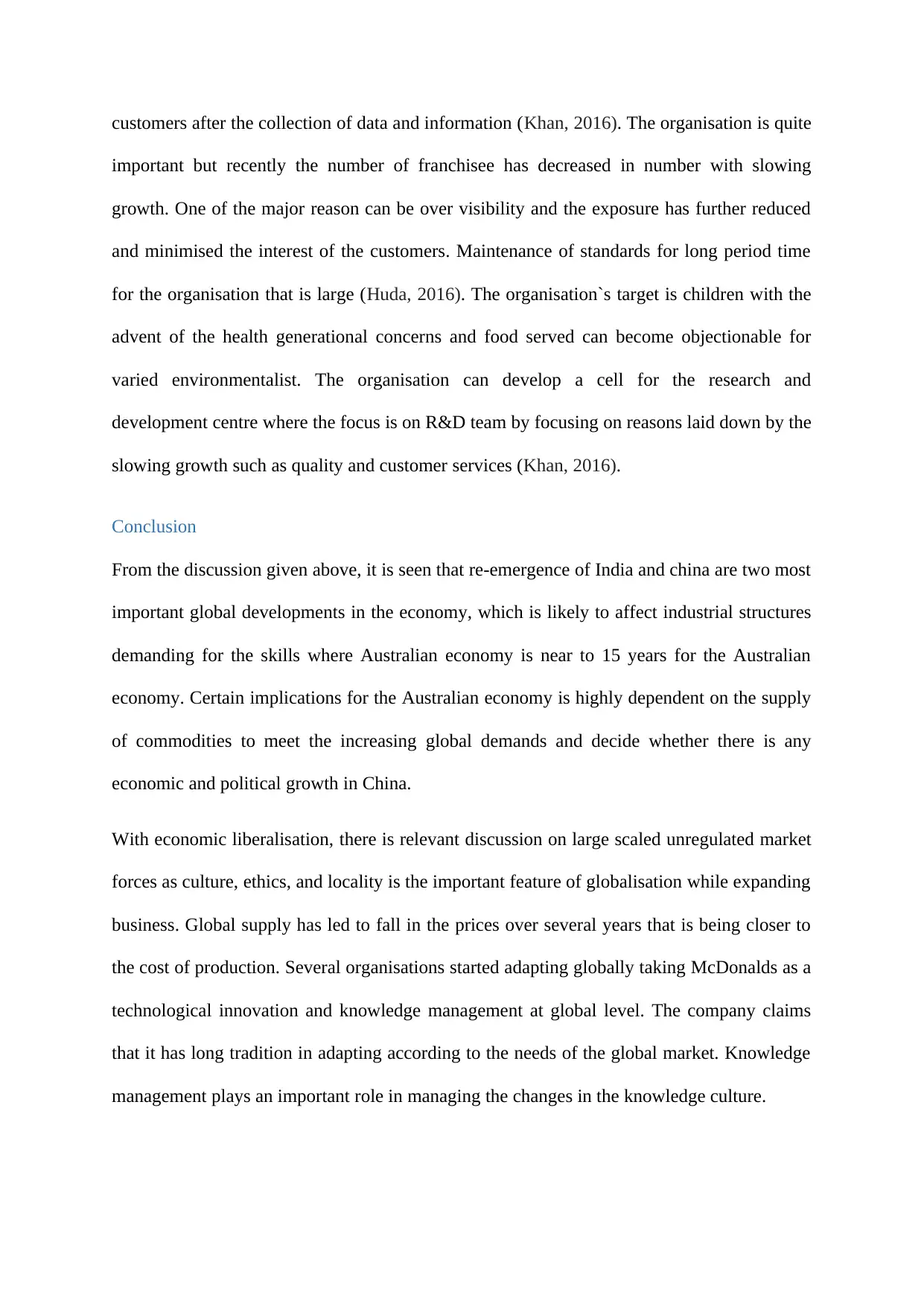
customers after the collection of data and information (Khan, 2016). The organisation is quite
important but recently the number of franchisee has decreased in number with slowing
growth. One of the major reason can be over visibility and the exposure has further reduced
and minimised the interest of the customers. Maintenance of standards for long period time
for the organisation that is large (Huda, 2016). The organisation`s target is children with the
advent of the health generational concerns and food served can become objectionable for
varied environmentalist. The organisation can develop a cell for the research and
development centre where the focus is on R&D team by focusing on reasons laid down by the
slowing growth such as quality and customer services (Khan, 2016).
Conclusion
From the discussion given above, it is seen that re-emergence of India and china are two most
important global developments in the economy, which is likely to affect industrial structures
demanding for the skills where Australian economy is near to 15 years for the Australian
economy. Certain implications for the Australian economy is highly dependent on the supply
of commodities to meet the increasing global demands and decide whether there is any
economic and political growth in China.
With economic liberalisation, there is relevant discussion on large scaled unregulated market
forces as culture, ethics, and locality is the important feature of globalisation while expanding
business. Global supply has led to fall in the prices over several years that is being closer to
the cost of production. Several organisations started adapting globally taking McDonalds as a
technological innovation and knowledge management at global level. The company claims
that it has long tradition in adapting according to the needs of the global market. Knowledge
management plays an important role in managing the changes in the knowledge culture.
important but recently the number of franchisee has decreased in number with slowing
growth. One of the major reason can be over visibility and the exposure has further reduced
and minimised the interest of the customers. Maintenance of standards for long period time
for the organisation that is large (Huda, 2016). The organisation`s target is children with the
advent of the health generational concerns and food served can become objectionable for
varied environmentalist. The organisation can develop a cell for the research and
development centre where the focus is on R&D team by focusing on reasons laid down by the
slowing growth such as quality and customer services (Khan, 2016).
Conclusion
From the discussion given above, it is seen that re-emergence of India and china are two most
important global developments in the economy, which is likely to affect industrial structures
demanding for the skills where Australian economy is near to 15 years for the Australian
economy. Certain implications for the Australian economy is highly dependent on the supply
of commodities to meet the increasing global demands and decide whether there is any
economic and political growth in China.
With economic liberalisation, there is relevant discussion on large scaled unregulated market
forces as culture, ethics, and locality is the important feature of globalisation while expanding
business. Global supply has led to fall in the prices over several years that is being closer to
the cost of production. Several organisations started adapting globally taking McDonalds as a
technological innovation and knowledge management at global level. The company claims
that it has long tradition in adapting according to the needs of the global market. Knowledge
management plays an important role in managing the changes in the knowledge culture.
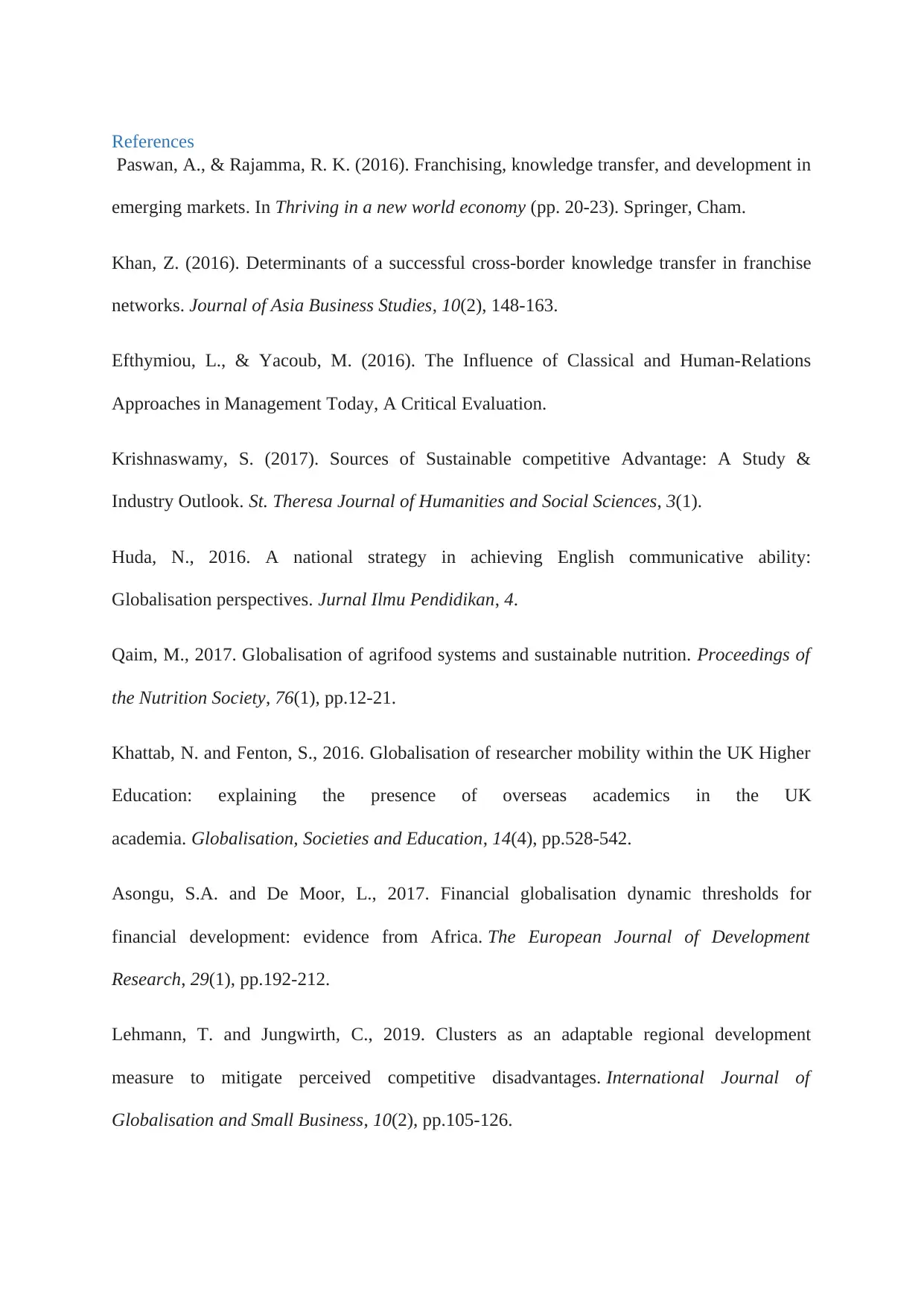
References
Paswan, A., & Rajamma, R. K. (2016). Franchising, knowledge transfer, and development in
emerging markets. In Thriving in a new world economy (pp. 20-23). Springer, Cham.
Khan, Z. (2016). Determinants of a successful cross-border knowledge transfer in franchise
networks. Journal of Asia Business Studies, 10(2), 148-163.
Efthymiou, L., & Yacoub, M. (2016). The Influence of Classical and Human-Relations
Approaches in Management Today, A Critical Evaluation.
Krishnaswamy, S. (2017). Sources of Sustainable competitive Advantage: A Study &
Industry Outlook. St. Theresa Journal of Humanities and Social Sciences, 3(1).
Huda, N., 2016. A national strategy in achieving English communicative ability:
Globalisation perspectives. Jurnal Ilmu Pendidikan, 4.
Qaim, M., 2017. Globalisation of agrifood systems and sustainable nutrition. Proceedings of
the Nutrition Society, 76(1), pp.12-21.
Khattab, N. and Fenton, S., 2016. Globalisation of researcher mobility within the UK Higher
Education: explaining the presence of overseas academics in the UK
academia. Globalisation, Societies and Education, 14(4), pp.528-542.
Asongu, S.A. and De Moor, L., 2017. Financial globalisation dynamic thresholds for
financial development: evidence from Africa. The European Journal of Development
Research, 29(1), pp.192-212.
Lehmann, T. and Jungwirth, C., 2019. Clusters as an adaptable regional development
measure to mitigate perceived competitive disadvantages. International Journal of
Globalisation and Small Business, 10(2), pp.105-126.
Paswan, A., & Rajamma, R. K. (2016). Franchising, knowledge transfer, and development in
emerging markets. In Thriving in a new world economy (pp. 20-23). Springer, Cham.
Khan, Z. (2016). Determinants of a successful cross-border knowledge transfer in franchise
networks. Journal of Asia Business Studies, 10(2), 148-163.
Efthymiou, L., & Yacoub, M. (2016). The Influence of Classical and Human-Relations
Approaches in Management Today, A Critical Evaluation.
Krishnaswamy, S. (2017). Sources of Sustainable competitive Advantage: A Study &
Industry Outlook. St. Theresa Journal of Humanities and Social Sciences, 3(1).
Huda, N., 2016. A national strategy in achieving English communicative ability:
Globalisation perspectives. Jurnal Ilmu Pendidikan, 4.
Qaim, M., 2017. Globalisation of agrifood systems and sustainable nutrition. Proceedings of
the Nutrition Society, 76(1), pp.12-21.
Khattab, N. and Fenton, S., 2016. Globalisation of researcher mobility within the UK Higher
Education: explaining the presence of overseas academics in the UK
academia. Globalisation, Societies and Education, 14(4), pp.528-542.
Asongu, S.A. and De Moor, L., 2017. Financial globalisation dynamic thresholds for
financial development: evidence from Africa. The European Journal of Development
Research, 29(1), pp.192-212.
Lehmann, T. and Jungwirth, C., 2019. Clusters as an adaptable regional development
measure to mitigate perceived competitive disadvantages. International Journal of
Globalisation and Small Business, 10(2), pp.105-126.
⊘ This is a preview!⊘
Do you want full access?
Subscribe today to unlock all pages.

Trusted by 1+ million students worldwide
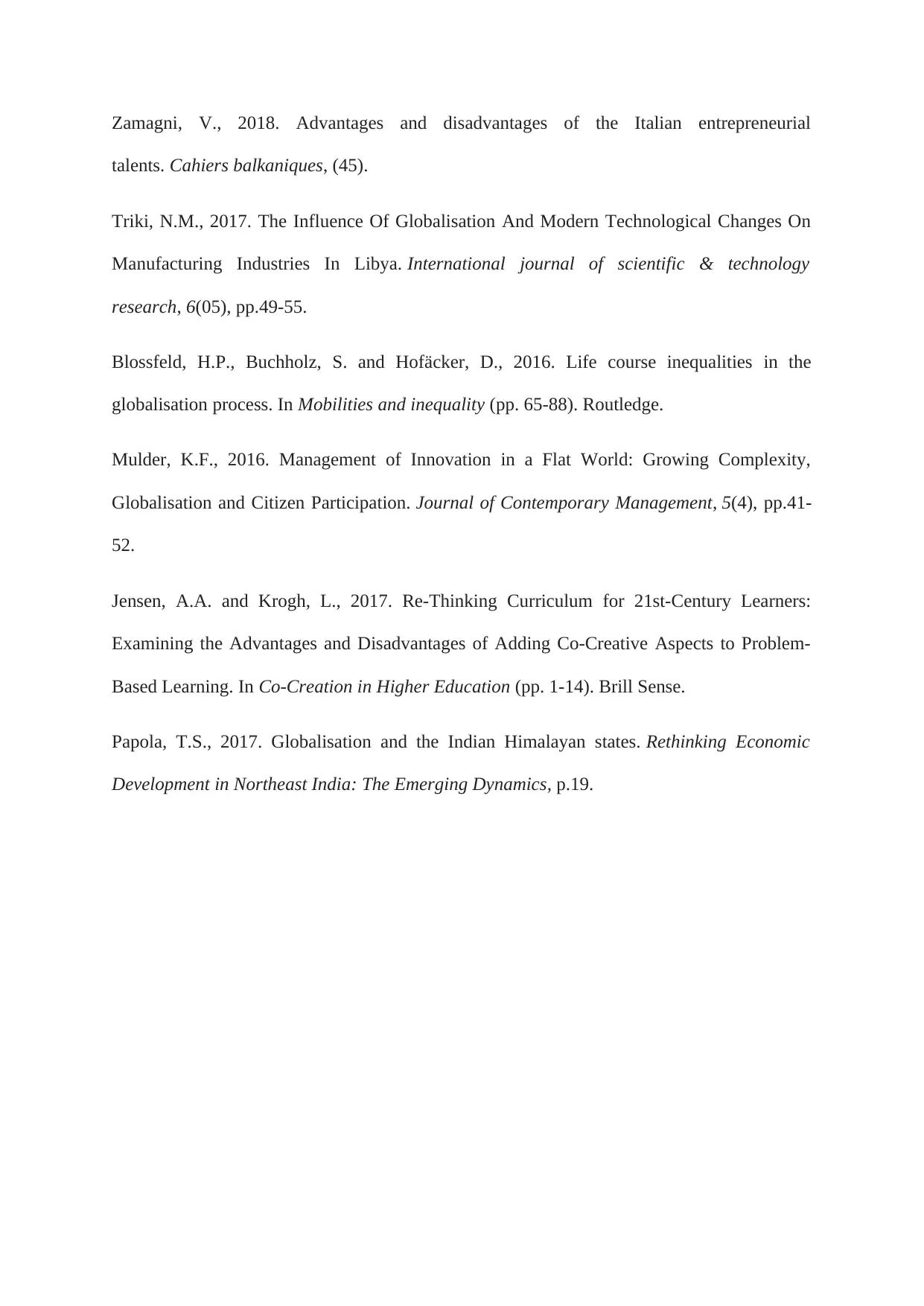
Zamagni, V., 2018. Advantages and disadvantages of the Italian entrepreneurial
talents. Cahiers balkaniques, (45).
Triki, N.M., 2017. The Influence Of Globalisation And Modern Technological Changes On
Manufacturing Industries In Libya. International journal of scientific & technology
research, 6(05), pp.49-55.
Blossfeld, H.P., Buchholz, S. and Hofäcker, D., 2016. Life course inequalities in the
globalisation process. In Mobilities and inequality (pp. 65-88). Routledge.
Mulder, K.F., 2016. Management of Innovation in a Flat World: Growing Complexity,
Globalisation and Citizen Participation. Journal of Contemporary Management, 5(4), pp.41-
52.
Jensen, A.A. and Krogh, L., 2017. Re-Thinking Curriculum for 21st-Century Learners:
Examining the Advantages and Disadvantages of Adding Co-Creative Aspects to Problem-
Based Learning. In Co-Creation in Higher Education (pp. 1-14). Brill Sense.
Papola, T.S., 2017. Globalisation and the Indian Himalayan states. Rethinking Economic
Development in Northeast India: The Emerging Dynamics, p.19.
talents. Cahiers balkaniques, (45).
Triki, N.M., 2017. The Influence Of Globalisation And Modern Technological Changes On
Manufacturing Industries In Libya. International journal of scientific & technology
research, 6(05), pp.49-55.
Blossfeld, H.P., Buchholz, S. and Hofäcker, D., 2016. Life course inequalities in the
globalisation process. In Mobilities and inequality (pp. 65-88). Routledge.
Mulder, K.F., 2016. Management of Innovation in a Flat World: Growing Complexity,
Globalisation and Citizen Participation. Journal of Contemporary Management, 5(4), pp.41-
52.
Jensen, A.A. and Krogh, L., 2017. Re-Thinking Curriculum for 21st-Century Learners:
Examining the Advantages and Disadvantages of Adding Co-Creative Aspects to Problem-
Based Learning. In Co-Creation in Higher Education (pp. 1-14). Brill Sense.
Papola, T.S., 2017. Globalisation and the Indian Himalayan states. Rethinking Economic
Development in Northeast India: The Emerging Dynamics, p.19.
1 out of 10
Related Documents
Your All-in-One AI-Powered Toolkit for Academic Success.
+13062052269
info@desklib.com
Available 24*7 on WhatsApp / Email
![[object Object]](/_next/static/media/star-bottom.7253800d.svg)
Unlock your academic potential
Copyright © 2020–2025 A2Z Services. All Rights Reserved. Developed and managed by ZUCOL.





